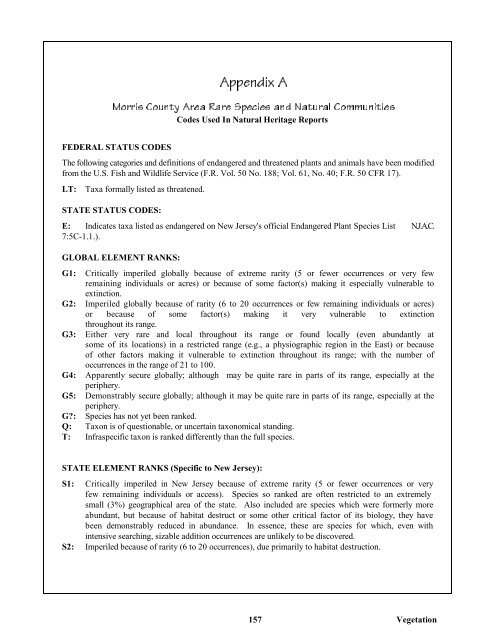A Natural Resource Management Guide for the County of Morris A ...
A Natural Resource Management Guide for the County of Morris A ...
A Natural Resource Management Guide for the County of Morris A ...
Create successful ePaper yourself
Turn your PDF publications into a flip-book with our unique Google optimized e-Paper software.
Appendix A<br />
<strong>County</strong> Area Rare Species and <strong>Natural</strong> Communities<br />
<strong>Morris</strong><br />
Codes Used In <strong>Natural</strong> Heritage Reports<br />
FEDERAL STATUS CODES<br />
The following categories and definitions <strong>of</strong> endangered and threatened plants and animals have been modified<br />
from <strong>the</strong> U.S. Fish and Wildlife Service (F.R. Vol. 50 No. 188; Vol. 61, No. 40; F.R. 50 CFR 17).<br />
LT:<br />
Taxa <strong>for</strong>mally listed as threatened.<br />
STATE STATUS CODES:<br />
E: Indicates taxa listed as endangered on New Jersey's <strong>of</strong>ficial Endangered Plant Species List N.J.A.C.<br />
7:5C-1.1.).<br />
GLOBAL ELEMENT RANKS:<br />
G1: Critically imperiled globally because <strong>of</strong> extreme rarity (5 or fewer occurrences or very few<br />
remaining individuals or acres) or because <strong>of</strong> some factor(s) making it especially vulnerable to<br />
extinction.<br />
G2: Imperiled globally because <strong>of</strong> rarity (6 to 20 occurrences or few remaining individuals or acres)<br />
or because <strong>of</strong> some factor(s) making it very vulnerable to extinction<br />
throughout its range.<br />
G3: Ei<strong>the</strong>r very rare and local throughout its range or found locally (even abundantly at<br />
some <strong>of</strong> its locations) in a restricted range (e.g., a physiographic region in <strong>the</strong> East) or because<br />
<strong>of</strong> o<strong>the</strong>r factors making it vulnerable to extinction throughout its range; with <strong>the</strong> number <strong>of</strong><br />
occurrences in <strong>the</strong> range <strong>of</strong> 21 to 100.<br />
G4: Apparently secure globally; although may be quite rare in parts <strong>of</strong> its range, especially at <strong>the</strong><br />
periphery.<br />
G5: Demonstrably secure globally; although it may be quite rare in parts <strong>of</strong> its range, especially at <strong>the</strong><br />
periphery.<br />
G?: Species has not yet been ranked.<br />
Q: Taxon is <strong>of</strong> questionable, or uncertain taxonomical standing.<br />
T: Infraspecific taxon is ranked differently than <strong>the</strong> full species.<br />
STATE ELEMENT RANKS (Specific to New Jersey):<br />
S1: Critically imperiled in New Jersey because <strong>of</strong> extreme rarity (5 or fewer occurrences or very<br />
few remaining individuals or access). Species so ranked are <strong>of</strong>ten restricted to an extremely<br />
small (3%) geographical area <strong>of</strong> <strong>the</strong> state. Also included are species which were <strong>for</strong>merly more<br />
abundant, but because <strong>of</strong> habitat destruct or some o<strong>the</strong>r critical factor <strong>of</strong> its biology, <strong>the</strong>y have<br />
been demonstrably reduced in abundance. In essence, <strong>the</strong>se are species <strong>for</strong> which, even with<br />
intensive searching, sizable addition occurrences are unlikely to be discovered.<br />
S2: Imperiled because <strong>of</strong> rarity (6 to 20 occurrences), due primarily to habitat destruction.<br />
157<br />
Vegetation


